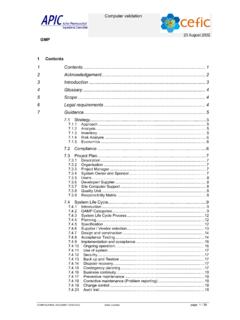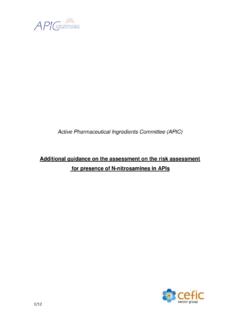Transcription of SUPPLIER QUALIFICATION & MANAGEMENT GUIDELINE
1 ACTIVE PHARMACEUTICAL INGREDIENTS COMMITTEE (APIC) SUPPLIER QUALIFICATION & MANAGEMENT GUIDELINE December 2009 2 Content 1. introduction 2. Chapter 1: SUPPLIER Selection 3. Chapter 2: Due Diligence 4. Chapter 3: Quality Assessment 5. Chapter 4: Change Control + Production Assessment 6. Chapter 5: Supply Chain Security 7. Chapter 6: Ongoing Monitoring and Evaluation 8. Appendices Appendix 1: Examples of Critical/ non Critical Raw Materials Appendix 2: SUPPLIER Selection Check List Appendix 3: Due Diligence Check List Appendix 4: SUPPLIER Questionnaires Appendix 5: Check list for Change Control Assessment 3 introduction Manufacture of Medicinal Products and the Active Pharmaceutical Ingredients (APIs) used as starting materials in the production of these products is subject to strict good manufacturing practice regulations that are designed to ensure their quality, safety and efficacy.
2 This ensures that patients worldwide and at any time can have confidence in the quality, safety and efficacy of medicines. The cGMP regulations for final medicinal products are clearly defined in each country and region. The content of the regulations may vary but the objectives are the same: - To deliver high quality, safe medicines manufactured and distributed following controlled procedures to treat diseases and - To prevent deaths, serious illnesses, adverse events or product recalls resulting from deficiencies in the manufacturing and distribution processes. While in the vast majority of cases, the pharmaceutical industry, under the oversight of the Regulatory Authorities and inspectorates consistently applies appropriate cGMP practices, there are many cases known where the standards expected from manufacturing companies have not been maintained.
3 Some of these cases had very serious consequences :- The heparin case in 2008, causing around 150 fatalities in the due to deliberate contamination of the API with a bogus substance (oversulphated chondroitin sulphate) The many scandals involving the contamination of glycerine with diethylene glycol that led amongst others to 107 deaths in the USA (1937), around 300 deaths in Bangladesh (1990), 88 deaths (young children) in Haiti ( 1996 ), and 138 deaths in Panama (2006), due to lack of controls in the distribution networks of glycerine and in the medicinal product manufacturing sites involved The gentamicin sulphate case in which unknown contaminants caused in total around 65 deaths in the USA in 1994 and 1999 respectively Other cases of counterfeit medicines, falsified APIs and medicinal product recalls due to adulteration of medicines or APIs released to the market underline the potential magnitude of the risk to patients if the supply chain for medicines is not properly qualified.
4 In some cases business pressures to reduce costs results in sourcing APIs and the raw materials used in their manufacturing process at the lowest cost. While this practice, in and of itself, does not create non-compliance, it does create an opportunity for unscrupulous suppliers to insert themselves into the supply chain and introduce substandard materials. This situation also highlights the need for clarity regarding expectations and requirements for SUPPLIER quality and assurance of the full supply chain. 4 The scope of this guidance document is to share the best practices of APIC member companies on systems to be implemented to adequately manage suppliers through the complete life cycle of the product, including SUPPLIER Selection Process based on definition of the User s Requirements for a material with as a minimum a specification o Sample evaluation including where necessary laboratory and /or production trials Due Diligence process of potential suppliers of critical raw materials.
5 Registered intermediates and APIs Quality Assessment of all suppliers Change control and production assessment as necessary Supply chain security Ongoing monitoring and evaluation The target audience for the guidance document is primarily API Manufacturers while it may also be used by medicinal product manufacturers who are primarily responsible to qualify their suppliers / manufacturers of APIs used as Starting Materials in the manufacture of medicinal products. We have classified the materials into the following four categories based on quality criticality to the API manufacturing process and on risk related to potential for harm to the patients:- Non-critical raw materials Critical raw materials (including API Starting Materials) Registered intermediates APIs 5 The quantity of materials in each category is likely to decrease as the criticality increases as indicated in the following triangle: In terms of defining the categories of materials we recommend that companies review the use of the material based on the ICH Q7 definition of Critical.
6 - Critical describes a process step, process condition, test requirement, or other relevant parameter or item that must be controlled within predetermined criteria to ensure that the API meets its specification . For an API manufacturing process involving multiple-step synthesis, raw materials used in the early steps are likely to be less critical than those used in the final API step given that accurate specifications will be defined for all raw materials. To assess the risk to patients related to the material we recommend that companies follow ICH Q9 for their Quality Risk MANAGEMENT process and use the ICH Q9 definition of Risk:- Risk is the combination of the probability of occurrence of harm and the severity of the harm to the patient or consumer . For example the risk of particulate or microbiological contamination from a reagent, solvent, water system, utility or primary packaging material that are in direct contact with an API will or greater than materials used earlier in the process.
7 We recommend that suppliers of all the materials should be approved using the Company s Change Control Procedures and / or SUPPLIER Approval Procedures. Change Non critical Raw Materials Critical Raw Materials Registered Intermediates Intermediates APIs Increasing Levels of GMP 6 control requirements would also be more stringent for critical raw materials (including API Starting Materials), registered Intermediates and API and should include a Regulatory Assessment. Definitions: Raw materials can be sub-categorised into three different classes: a. Those that are widely commercially available and are used in multiple industries, for example acids, bases, solvents, filter aids, petroleum based raw materials, naturally occurring raw materials, packaging materials, water systems or utilities in contact with the API such as nitrogen or compressed air.
8 B. Those that are commercially available for use in the API Industry such as catalysts, enzymes, chemical (including chiral) building blocks. c. API Starting Materials. These may be generally available or involve custom synthesis or specific process development by the SUPPLIER before becoming available on an industrial scale. Registered intermediates usually involve custom synthesis or process development by the SUPPLIER . APIs will be manufactured under custom synthesis or contract manufacture or will be generally available if used in the manufacture of off-patent medicinal products. Further examples of types of materials covered by the scope of this guidance document and guidance on criticality are given in Appendix 1. Guidance: The quality system requirements to identify, select, approve and qualify suppliers of all materials used in the manufacture of APIs and medicinal products are clearly defined in the GMP guidelines .
9 Manufacturers of medicinal products, APIs and registered intermediates for APIs are responsible for approving and qualifying their suppliers and to monitor on an ongoing basis the performance of their critical suppliers. The Regulatory Agencies will and do inspect the SUPPLIER QUALIFICATION procedures used by medicinal product manufacturers and expect that they periodically audit their API SUPPLIER / manufacturer. As part of this audit, the medicinal product manufacturer should ensure that the API SUPPLIER / manufacturer also has SUPPLIER QUALIFICATION procedures in place for their suppliers of critical and non-critical raw materials, API Starting Materials, Registered Intermediates and APIs (in the case of contract manufacturers). In relation to critical raw materials the Authorities will also expect a monitoring programme to be in 7 place and for the manufacture to have clear oversight of the changes with possible quality impact made by their suppliers.
10 Inspectors will also expect that the distribution and supply chains have also been evaluated and that controls are in place to ensure there is adequate Supply Chain Security, to avoid possible fraudulent practices and to ensure that appropriate transportation conditions ( temperature and humidity) are applied during distribution where this is required based on the properties of the materials. The pre-requisites for approval of suppliers of all materials including non critical raw materials are that the material meets the specification defined by the customer confirmed by 1) sample evaluation (QC testing) and that 2) there is an evaluation of the quality system in place designed to assure and control the manufacture, testing, release and distribution of the material.


